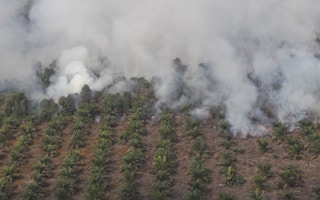Roughly half of Indonesia’s natural forest loss occurs outside officially designated concession areas, concludes a new assessment that also finds higher deforestation rates in places with worse forest governance scores.
The report, released last month by Forest Watch Indonesia, is based on analysis of satellite data spanning the archipelago. Unlike assessments by the Ministry of Forestry, the data includes areas outside the “forest estate”.
The findings are sobering, showing that Indonesia’s forest cover is now down to 46 per cent of its land mass, a drop of 2.5 percentage points since 2009. Natural forest cover in Indonesia now amounts to 82.5 million hectares, more than half of which exists in just three provinces: Papua in Indonesian New Guinea, East Kalimantan (including North Kalimantan), and West Kalimantan.
Forest Watch Indonesia’s analysis concludes that Indonesia averaged 917,000 ha of natural forest per year between 2009 and 2013, well above the figure cited by the Ministry of Forestry. More than three-fifths of that loss occurred in Kalimantan and Sumatra.
“
Those with lowest governance indices had greatest deforested areas compared to the other districts
Forest Watch Indonesia
The data also revealed that just under half of natural forest loss occurs outside concession areas. The report didn’t break out drivers of deforestation in non-concession areas, but agriculture, oil palm, rubber, and fire are typically the biggest contributors.
Within concessions, deforestation is pretty evenly distributed between areas permitted for oil palm, timber plantations, and mining areas. Logging concessions had the lowest extent of deforestation despite accounting for the largest area of natural forest. Timber estates and oil palm plantations lost the largest percentage of their forest cover.
Forest Watch Indonesia also looked at an important underlying driver of deforestation in Indonesia: forest governance. For five districts, Forest Watch Indonesia compared deforestation to a forest management index, a proxy for forest governance.
It found “those with lowest governance indices had greatest deforested areas compared to the other districts” indicating that “poor forest governance accelerates forest resource degradation”.
On the governance front, the report documented questionable practices within the forestry sector, including 58 percent of active concessions failing to acquire either sustainability or legality certifications. Timber plantation companies planted only a fraction of the lands they cleared.
A fundamental problem, says the report, is the bureaucracy charged with managing Indonesia’s forests.
“Forestry issues are becoming increasingly complex with minimum organizational capacity in the site level, including poor relations between central and local governments,” states the report. “A number of forestry issues are not immediately resolved because the government (such as Ministry of Forestry50) does not prioritize resolution of the root causes of these forestry issues.”
Forest Watch Indonesia therefore puts forest governance at the center of efforts to fix Indonesia’s forestry sector. It calls for several programs that resolve conflicting forest claims, protect and restore forests, and strengthen forest management.
Before those can happen however, Indonesia needs better and more transparent data on forest use, better constructed forestry laws with consistent law enforcement, recognition of community rights, a fair and competitive business climate, and stronger local forestry agencies.
“Weakness of forest governance implementation by the government has indirectly created room for corrupt practices,” states the report.
“Corrupt and non-transparent legal, political, and economic systems that views forest resources only as sources of revenues and profits, have greatly contributed to forest degradation in Indonesia. Disparities due to poor government roles and capacity in executing monitoring functions provide incentive to unscrupulous forestry players to destructively exploit forest resources.”










